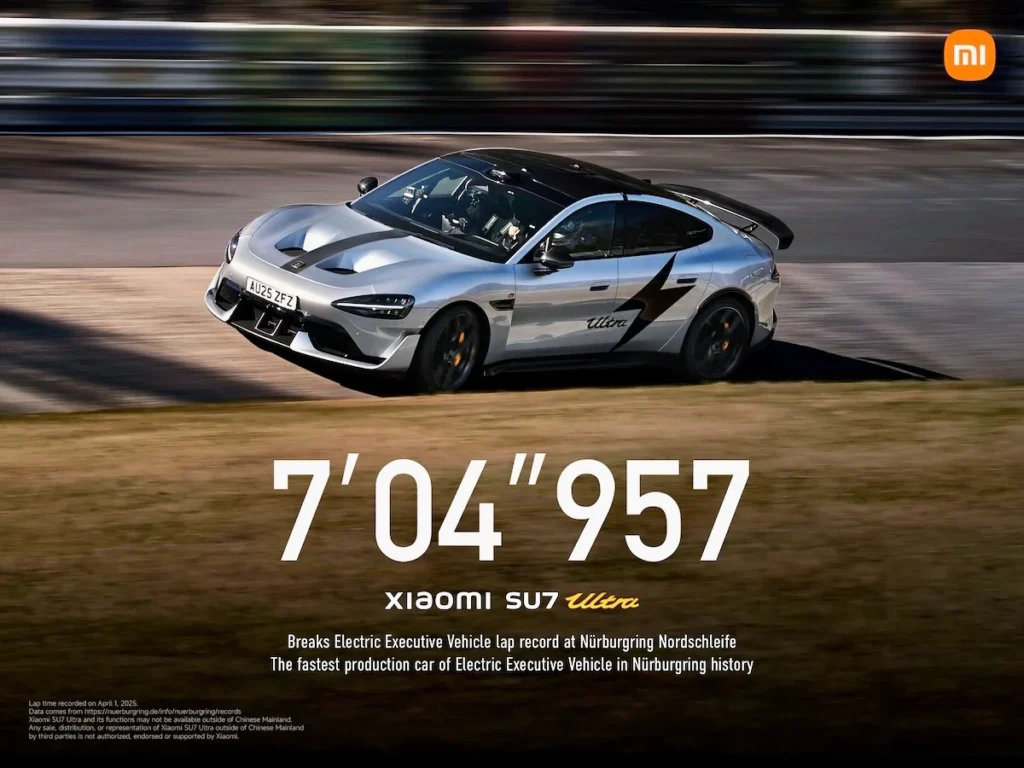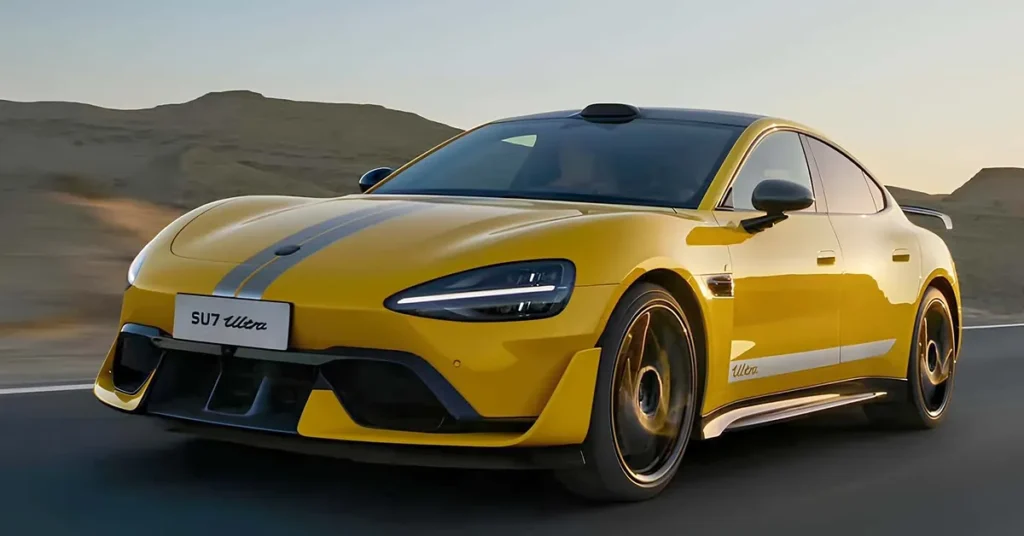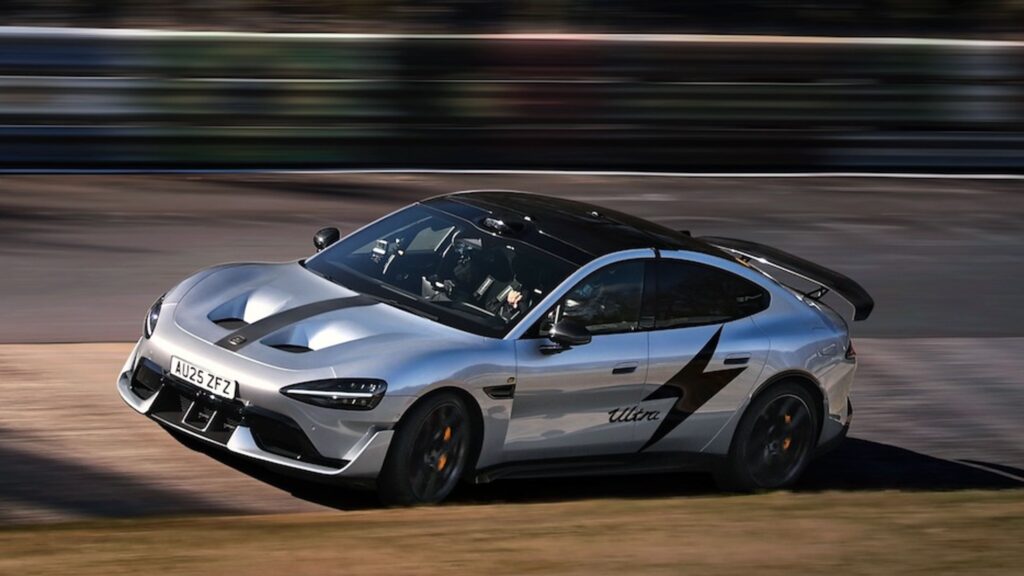Ever floored the gas in a car so fast it felt like your soul was trying to catch up? That’s the vibe I got watching the Xiaomi SU7 Ultra scream around the Nürburgring Nordschleife in a blistering 7 minutes and 4.957 seconds, snatching the crown as the fastest production electric vehicle ever on that legendary track.
I mean, a Chinese tech company-known for phones and scooters-building a 1,548-horsepower electric sedan that smokes a Porsche Taycan Turbo GT? That’s not just a plot twist; it’s a whole new script for the car world.
Priced at a jaw-dropping $50,000-$60,000, the SU7 Ultra delivers hypercar thrills for the cost of a loaded Camry.
As a gearhead who’s spent a decade drooling over unobtainable supercars, I’m stoked to break down seven reasons why this record redefines affordable performance-and why it’s got me rethinking my dream garage.
Unprecedented Value for Hypercar Performance

Let’s start with the sticker shock-or lack thereof. The Xiaomi SU7 Ultra pumps out 1,548 horsepower, hits 0-60 mph in 1.98 seconds, and costs about $50,000-$60,000. Compare that to a Porsche Taycan Turbo GT, which starts at $209,000 and still got dusted by 2.6 seconds at the ‘Ring.
That’s a cool $150,000 you’re saving for, say, a nice vacation or a down payment on a house. I once test-drove a used Lamborghini Gallardo for kicks, and let me tell you, the $120,000 price tag for 500 hp felt like highway robbery compared to what Xiaomi’s offering. This car’s power-to-price ratio is like finding a Michelin-starred meal at Taco Bell prices.
And it’s not just about raw numbers. The SU7 Ultra is road-legal, meaning you can drive it to the grocery store after tearing up a track. It’s got a dual-motor setup with Xiaomi’s Super Motor V8s, which sounds like something Tony Stark would build in his garage.
For the average enthusiast, this means you’re getting a car that rivals million-dollar hypercars without needing to sell your kidney.
Breaking the Nürburgring Barrier with a Chinese EV
The Nürburgring isn’t just a track; it’s the automotive world’s Mount Everest. A 20.8 km gauntlet of 73 turns, it chews up cars and spits out reputations.
When Xiaomi, a company I associated with budget earbuds, announced their SU7 Ultra beat the Taycan’s 7:07.55 record, I nearly spilled my coffee.
This is the first time a Chinese car has claimed any class record at the ‘Ring, and it’s a big deal. It’s like China just walked into a European car party and stole the DJ’s mic.
What’s wild is how Xiaomi pulled it off. The SU7 Ultra’s chassis is tuned like a Swiss watch, with aerodynamics that keep it glued to the track.
I remember watching a buddy in a modded BMW M3 struggle to keep up with a pro driver at a local circuit-imagine that M3 getting lapped by this Xiaomi beast. It’s proof that Chinese automakers aren’t just playing catch-up; they’re rewriting the rules.
Software Unlocks as a New Performance Paradigm
Here’s where things get spicy. When the SU7 Ultra first hit the streets, Xiaomi capped its power at 900 hp via software, even though the hardware could handle 1,548 hp. Owners were pissed—imagine buying a Ferrari only to find out it’s locked in eco mode.
After some serious online backlash (think X posts with more fire emojis than a barbecue), Xiaomi released a software update to unleash the full beast.
I had a similar moment with my old gaming PC, where a firmware update turned it from sluggish to snappy. For SU7 Ultra owners, this means you’re getting hypercar performance without shelling out for new parts.
This software trick is a game-changer. It’s like your car can level up with a download, no wrench required.
But it also raises questions about how much control manufacturers should have over your car’s potential. For now, Xiaomi’s free unlock is a win, saving owners from pricey aftermarket mods.
Accelerating the Shift to High-Performance EVs

The SU7 Ultra isn’t just fast; it’s green. Its electric powertrain means you’re burning rubber, not dinosaurs, which is a big deal when gas prices are higher than my stress levels during rush hour.
EVs like this are pushing the industry toward a cleaner future, and the ‘Ring record proves you don’t have to sacrifice thrills for eco-cred. I took a Tesla Model 3 for a spin last year, and while it was quick, the SU7 Ultra’s 1,548 hp makes it feel like a golf cart.
This record also lights a fire under competitors. Brands like Tesla, Porsche, and even legacy names like BMW are now scrambling to keep up. More competition means better EVs for us, with lower prices and cooler tech. It’s like the EV world just got a Red Bull sponsorship.
Redefining Safety Standards for Affordable Supercars
With great power comes… a need for great brakes. The SU7 Ultra’s 1.98-second 0-60 mph sprint is heart-stopping, but it’s not all fun and games.
Cars this fast need top-tier safety systems-think advanced traction control, monster brakes, and stability tech that keeps you from yeeting into a ditch.
Xiaomi’s packed the SU7 Ultra with these goodies, but as someone who’s spun out on a wet autocross course (don’t ask), I can’t stress enough: you’ve got to respect this kind of power.
The ‘Ring is a controlled environment, but public roads? That’s where things get dicey. Owners need to channel their inner racecar driver responsibly, or that 1,548 hp could turn a commute into a headline.
Still, Xiaomi’s safety tech could reduce accident risks to near zero if used right, making this a supercar you can live with daily.
Consumer Trust and Transparency in the EV Era
That software cap drama? It’s a lesson in trust. When Xiaomi limited the SU7 Ultra’s power, the X platform lit up with complaints. I get it-nobody wants to feel like they bought a caged lion.
But Xiaomi’s quick response with a free unlock was a masterclass in listening to customers. It reminds me of when my local mechanic fessed up to a billing error and comped my next oil change-small moves that build loyalty.
This saga shows why transparency matters. If carmakers are going to play with software locks, they’d better be upfront about it. Xiaomi’s handling of this could set a standard, making brands think twice before pulling a bait-and-switch.
Accessibility Challenges and Global Aspirations
Here’s the bummer: you might not be able to buy an SU7 Ultra everywhere. Markets like Australia are likely out of luck, which stings for enthusiasts Down Under.
I felt the same when I learned my favorite JDM cars were Japan-only-pure torture. But Xiaomi’s global ambitions are clear. If they can make a ‘Ring-record-setting EV for $50,000, who’s to say they won’t crack open new markets soon?
The SU7 Ultra’s success could force other brands to rethink pricing and availability. Imagine a world where hypercar performance isn’t just for the 1%. Xiaomi’s paving the way, and I’m crossing my fingers for a US launch so I can beg for a test drive.
Conclusion

The Xiaomi SU7 Ultra’s 7:04.957 Nürburgring lap isn’t just a number; it’s a middle finger to the idea that insane performance has to cost a fortune. With 1,548 hp, a price tag that saves you $150,000 over a Taycan, and tech that’s pushing EVs into the future, this car is a wake-up call for the industry.
Sure, there are hiccups-software drama, limited markets-but Xiaomi’s proven they’re not messing around. As someone who’s spent years chasing the thrill of fast cars, I’m hyped to see where this leads.
So, keep your eyes on Xiaomi, folks. They’re not just building cars; they’re building a revolution. Want to join the ride? Check out Xiaomi’s latest updates or dive into Nürburgring’s wild history to see why this record matters.
And if you’re dreaming of affordable speed, maybe start saving for that SU7 Ultra—it’s worth it.
